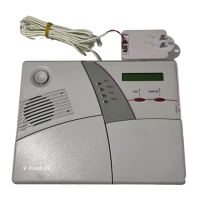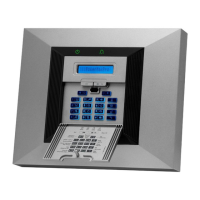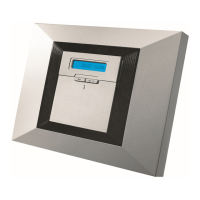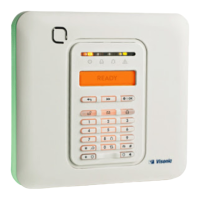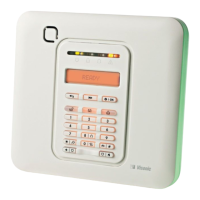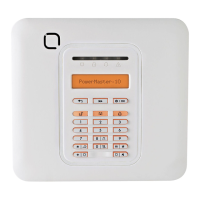4.4.20 Latchkey
(Fig. 4.4, location 20). Here you determine whether the
system can be armed in the latchkey mode. If the system
is armed this way, a “latchkey” message will be sent to
specific telephones upon disarming by a “latchkey user”
(users 5-8 or keyfob transmitters 5-8). This mode is useful
when parents at work want to be informed of a child’s
return from school. You can record a name for latchkey
users.
The options are: Latchkey ON and Latchkey OFF.
4.4.21 “Not Active”
(Fig. 4.4, location 21). Here you determine the time limit for
reception of signals from sensors used to monitor the
activity of sick, elderly or disabled people. If no device
detects and reports movement at least once within the
defined time limit, a “not-active” alert is initiated.
Options: 3, 6, 12, 24, 48, 72 hours and no act disable.
Note: The Not Active timer is defined for the entire alarm
system for the above hour options and not per partition (in a
PowerMaxComplete Partition system). Subsequently, a
dedicated timer is assigned to each partition.
4.4.22 Back Light
(Fig. 4.4, location 22). Here you determine whether the
keypad back lighting will remain on at all times or will come
on when a key is pressed and go off within 10 seconds if
no further keystrokes are sensed.
The two options are: always on and off after 10 s.
4.4.23 Duress
(Fig. 4.4, loc. 23)
A duress alarm (ambush) message can be sent to the
central station if the user is forced to disarm the system
under violence or menace. To initiate a duress message,
the user must disarm the system with the duress code
(2580 by default). Here you can change the code digits or
enter "0000" to disable the duress feature. The system
does not allow the user to program the duress code
saved in this memory location as an existing user code.
4.4.24 Piezo Siren
(Fig. 4.4, location 24). Here you determine whether the
internal siren will sound or remain silent upon alarm
(according to the user preference). Options: piezo siren
on, piezo siren off.
4.4.25 Reset Option
(Fig. 4.4, location 25) (Not applicable in the USA)
Here you determine whether the system can be rearmed
(after an event) by the user or only by the installer.
Options: user reset, engineer reset or anti code reset.
If Engineer Reset is selected, the system can be rearmed
only by the installer; by entering and exiting the installer
menu, by entering and exiting the event log (see section 7),
or by remote telephone. To perform Engineer Reset via the
telephone, establish communication with the
PowerMaxComplete (see user guide, Remote Control by
Telephone, steps 1-5) and continue as follows:
a. [*], [installer code], [#]
b. Wait for 2 beeps
c. [*], [1], [#]
d. [*], [99], [#]
Visonic uses Technistore anti code reset. Installers should
check with their central station for a code version (seed
code) which needs to be entered in menu 4.4.35.
Note: This menu is not available when partition is enabled.
4.4.26 Tamper Option
(Fig. 4.4, location 26). Here you determine whether zone
tamper will be reported or ignored. Available options are:
zone tamper ON and zone tamper OFF.
4.4.27 Siren On Line
(Fig. 4.4, location 27). Here you determine whether the
siren will be activated or not when the telephone line fails
during system armed state. Available options are: enable
on fail, disable on fail.
4.4.28 Memory Prompt
(Fig. 4.4, location 28). Here you determine whether the user
will receive indication that an alarm has been activated.
Available options are: enable and disable.
4.4.29 Disarm Option
(Fig. 4.4, location 29) (Not applicable in the USA)
Here you determine when it is possible to disarm the system:
A. Any time.
B. In AWAY mode, during entry delay, by using the
PowerMaxComplete keypad or wireless device (keyfob).
C. In AWAY mode, during entry delay, by using a wireless
device (keyfob) only (this is set as a default in UK to
comply with DD423).
D. During entry delay, or by using the PowerMaxComplete
keypad in AWAY mode.
Options: any time, on entry all, on entry wireless, or
entry + away kp.
4.4.30 Bell/Rep. Option
(Fig. 4.4, location 30). Here you determine whether an
alarm will be initiated (siren / report) when there is a
supervision / jamming failure during AWAY arming state.
Available options are: EN standard and other. When "EN
standard" is selected, if there is supervision / jamming
failure during AWAY arming, the siren is activated and the
events are reported as tamper events. When "Other" is
selected, there is no such activity during AWAY arming.
4.4.31 Low-Bat Ack
(Fig. 4.4, location 31). Here you determine whether the user
will hear or will not hear low battery sound when he tries to
disarm the system with a keyfob whose battery voltage is
low.
Available options are: keyfob L-B on (the user has to
acknowledge the keyfob low battery message) or keyfob
L-B off (the user does not have to acknowledge the keyfob
low battery message).
4.4.32 Screen Saver
(Fig. 4.4, location 32). Here you can determine that if no
key is pressed during more than 30 seconds the display
will read “PowerMax” (to prevent a possible intruder of
knowing the system status). You can determine that
normal display will return after pressing the button
followed by entering user code (Refresh by Code/Text by
Code) or after pressing any key (Refresh by Key/Text by
Key). When partition is enabled, you can also determine
that if no key is pressed during more than 30 seconds the
date and time will appear on the display. You can
determine that normal display will return after pressing the
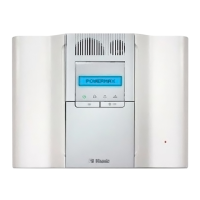
